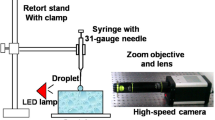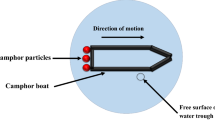Abstract
The influence of identical and distinct surface tensions on the coalescence and mixing of droplets after a direct collision on a wettability gradient surface (made from a self-assembled monolayer, SAM technique) was investigated. The results indicate that their mixing is driven sequentially by interior convection and diffusion; the convection endures less than 100 ms but dominates more than 60 % of the mixing. If the stationary droplet has a large surface tension (73.28 mN × m−1), whether the moving droplet has a large surface tension (73.28 mN × m−1) or a small surface tension (38.63 mN × m−1), the mushroom-shaped mixing pattern is generated within the coalesced droplet that enhances the convective mixing and also significantly enlarges the interface for mass diffusion. The mixing index of these two cases was greater than 0.8 at 120 s after the collision. For the cases in which the stationary droplet with a small surface tension collided by the moving droplet with a large surface tension, a mixing pattern with a round-head shape developed, which was insufficient to benefit the mixing. When the stationary and moving droplets both had small surface tension, the moving droplet was unable to merge with stationary droplet and had poor mixing quality due to the small surface Gibbs energy of both stationary and moving droplets. For the collision of droplets of identical surface tension, the surface tension affects the coalescence behavior; for the collision of droplets with distinct surface tension, the coalescence behavior and mixing quality depend on the colliding arrangement of stationary and moving droplets.







Similar content being viewed by others
References
Baviere R, Boutet J, Fouillet Y (2008) Dynamics of droplet transport induced by electrowetting actuation. Microfluid Nanofluidics 4(4):287–294. doi:10.1007/s10404-007-0173-4
Blanchette F, Messio L, Bush JWM (2009) The influence of surface tension gradients on drop coalescence. Phys Fluid 21(7). doi:10.1063/1.3177339
Castrejon-Pita JR, Betton ES, Kubiak KJ, Wilson MCT, Hutchings IM (2011) The dynamics of the impact and coalescence of droplets on a solid surface. Biomicrofluidics 5(1). doi:10.1063/1.3567099
Chaudhury MK, Whitesides GM (1992) How to make water run uphill. Science 256(5063):1539–1541
Chesters AK (1991) The modeling of coalescence processes in fluid liquid dispersions—a review of current understanding. Chem Eng Res Des 69(4):259–270
Cho SK, Moon HJ, Kim CJ (2003) Creating, transporting, cutting, and merging liquid droplets by electrowetting-based actuation for digital microfluidic circuits. J Microelectromechanical Syst 12(1):70–80. doi:10.1109/jmems.2002.807467
Choi S, Jamshidi A, Seok TJ, Wu MC, Zohdi TI, Pisano AP (2012) Fast, high-throughput creation of size-tunable micro/nanoparticle clusters via evaporative self-assembly in picoliter-scale droplets of particle suspension. Langmuir 28(6):3102–3111. doi:10.1021/la204362s
Danov KD, Denkov ND, Petsev DN, Ivanov IB, Borwankar R (1993) Coalescence dynamics of deformable brownian emulsion droplets. Langmuir 9(7):1731–1740. doi:10.1021/la00031a021
Darhuber AA, Valentino JP, Troian SM, Wagner S (2003) Thermocapillary actuation of droplets on chemically patterned surfaces by programmable microheater arrays. J Microelectromechanical Syst 12(6):873–879. doi:10.1109/jmems.2003.820267
Eggers J, Lister JR, Stone HA (1999) Coalescence of liquid drops. J Fluid Mech 401:293–310. doi:10.1017/s002211209900662x
Fair RB (2007) Digital microfluidics: is a true lab-on-a-chip possible? Microfluid Nanofluidics 3(3):245–281. doi:10.1007/s10404-007-0161-8
Fang W-F, Yang J-T (2009) A novel microreactor with 3D rotating flow to boost fluid reaction and mixing of viscous fluids. Sens Actuators B Chem 140(2):629–642. doi:10.1016/j.snb.2009.05.007
Fouillet Y, Jary D, Chabrol C, Claustre P, Peponnet C (2008) Digital microfluidic design and optimization of classic and new fluidic functions for lab on a chip systems. Microfluid Nanofluidics 4(3):159–165. doi:10.1007/s10404-007-0164-5
Hosokawa K, Fujii T, Endo I (1999) Handling of picoliter liquid samples in a poly(dimethylsiloxane)-based microfluidic device. Anal Chem 71(20):4781–4785. doi:10.1021/ac990571d
Huebner A, Sharma S, Srisa-Art M, Hollfelder F, Edel JB, deMello AJ (2008) Microdroplets: a sea of applications? Lab Chip 8(8):1244–1254. doi:10.1039/b806405a
Ichimura K, Oh SK, Nakagawa M (2000) Light-driven motion of liquids on a photoresponsive surface. Science 288(5471):1624–1626
Jose BM, Cubaud T (2012) Droplet arrangement and coalescence in diverging/converging microchannels. Microfluid Nanofluidics 12(5):687–696. doi:10.1007/s10404-011-0909-z
Kapur N, Gaskell PH (2007) Morphology and dynamics of droplet coalescence on a surface. Phys Rev E 75(5). doi:10.1103/PhysRevE.75.056315
Kim J, Longmire EK (2009) Investigation of binary drop rebound and coalescence in liquids using dual-field PIV technique. Exp Fluids 47(2):263–278. doi:10.1007/s00348-009-0659-9
Kinoshita H, Kaneda S, Fujii T, Oshima M (2007) Three-dimensional measurement and visualization of internal flow of a moving droplet using confocal micro-PIV. Lab Chip 7(3):338–346. doi:10.1039/b617391h
Lai Y-H, Hsu M-H, Yang J-T (2010a) Enhanced mixing of droplets during coalescence on a surface with a wettability gradient. Lab Chip 10(22):3149–3156. doi:10.1039/c003729j
Lai Y-H, Yang J-T, Shieh D-B (2010b) A microchip fabricated with a vapor-diffusion self-assembled-monolayer method to transport droplets across superhydrophobic to hydrophilic surfaces. Lab Chip 10(4):499–504. doi:10.1039/b917624a
Lu J, Corvalan CM (2012) Coalescence of viscous drops with surfactants. Chem Eng Sci 78:9–13. doi:10.1016/j.ces.2012.04.030
Lu HW, Bottausci F, Fowler JD, Bertozzi AL, Meinhart C, Kim CJ (2008) A study of EWOD-driven droplets by PIV investigation. Lab Chip 8(3):456–461. doi:10.1039/b717141b
Orme M (1997) Experiments on droplet collisions, bounce, coalescence and disruption. Prog Energy Combust Sci 23(1):65–79
Ortiz-Duenas C, Kim J, Longmire EK (2010) Investigation of liquid–liquid drop coalescence using tomographic PIV. Exp Fluids 49(1):111–129. doi:10.1007/s00348-009-0810-7
Paik P, Pamula VK, Pollack MG, Fair RB (2003) Electrowetting-based droplet mixers for microfluidic systems. Lab Chip 3(1):28–33. doi:10.1039/b210825a
Ruardy TG, Schakenraad JM, vanderMei HC, Busscher HJ (1997) Preparation and characterization of chemical gradient surfaces and their application for the study of cellular interaction phenomena. Surf Sci Rep 29(1):3–30. doi:10.1016/s0167-5729(97)00008-3
Sellier M, Trelluyer E (2009) Modeling the coalescence of sessile droplets. Biomicrofluidics 3(2). doi:10.1063/1.3154552
Stroock AD, Dertinger SKW, Ajdari A, Mezic I, Stone HA, Whitesides GM (2002) Chaotic mixer for microchannels. Science 295(5555):647–651. doi:10.1126/science.1066238
Ting S-C, Yang J-T (2009) Extracting energetically dominant flow features in a complicated fish wake using singular-value decomposition. Phys Fluid 21(4). doi:10.1063/1.3122802
Tung KY, Li CC, Yang JT (2009) Mixing and hydrodynamic analysis of a droplet in a planar serpentine micromixer. Microfluid Nanofluidics 7(4):545–557. doi:10.1007/s10404-009-0415-8
Wang C, Nguyen NT, Wong TN (2007) Optical measurement of flow field and concentration field inside a moving nanoliter droplet. Sens Actuators A Phys 133(2):317–322. doi:10.1016/j.sna.2006.06.026
Yang JT, Chen JC, Huang KJ, Yeh JA (2006) Droplet manipulation on a hydrophobic textured surface with roughened patterns. J Microelectromechanical Syst 15(3):697–707. doi:10.1109/jmems.2006.876791
Yang ZH, Chiu CY, Yang JT, Yeh JA (2009) Investigation and application of an ultrahydrophobic hybrid-structured surface with anti-sticking character. J Micromech Microeng 19(8). doi:10.1088/0960-1317/19/8/085022
Acknowledgments
National Science Council of Taiwan, ROC supported this work under grant number NSC-100-2120-M-002-013.
Author information
Authors and Affiliations
Corresponding author
Rights and permissions
About this article
Cite this article
Yeh, SI., Fang, WF., Sheen, HJ. et al. Droplets coalescence and mixing with identical and distinct surface tension on a wettability gradient surface. Microfluid Nanofluid 14, 785–795 (2013). https://doi.org/10.1007/s10404-012-1096-2
Received:
Accepted:
Published:
Issue Date:
DOI: https://doi.org/10.1007/s10404-012-1096-2




